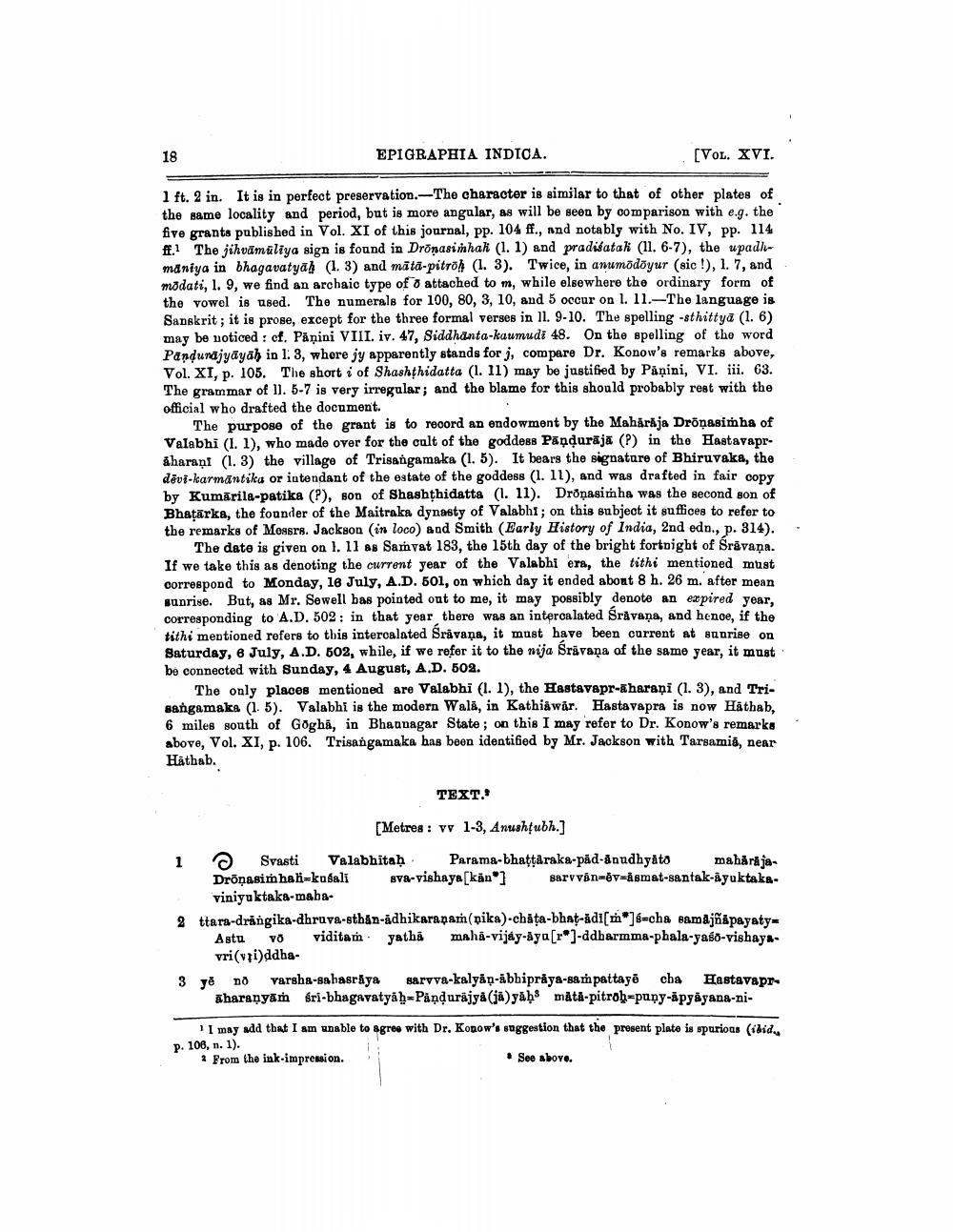________________
18
EPIGRAPHIA INDICA.
[Vol. XVI.
1 ft. 2 in. It is in perfect preservation. The character is similar to that of other plates of the same locality and period, but is more angular, as will be seen by comparison with e.g. the five grants published in Vol. XI of this journal, pp. 104 ff., and notably with No. IV, pp. 114 ff. The jihvāmüliya sign is found in Dronasimhah (1.1) and pradibatak (11. 6-7), the upadkmaniya in bhagavatyāh (1.3) and mātā-pitros (1. 3). Twice, in anumõdõyur (sic!), 1.7, and modati, 1. 9, we find an archaic type of attached to m, while elsewhere the ordinary form of the vowel is used. The numerals for 100, 80, 3, 10, and 5 occur on 1. 11.-The language is Sanskrit; it is prose, except for the three formal verses in 11. 9-10. The spelling -sthittya (1. 6) may be noticed : cf. Påņini VIII. iv. 47, Siddhanta-kaumudi 48. On the spelling of the word Pandundjyayah in 1.3, where jy apparently stands for y, compare Dr. Konow's remarks above, Vol. XI, p. 105. The short i of Shashthidatta (1. 11) may be justified by Panini, VI. iii. 63. The grammar of 1]. 5-7 is very irregular; and the blame for this should probably rest with the official who drafted the document.
The purpose of the grant is to record an endowment by the Maharija Drönasimha of Valabhi (1. 1), who made over for the cult of the goddess Pandurājā (?) in the Hastavaprå haraņi (1.3) the village of Trisangamaka (1. 5). It bears the signature of Bhiruvaka, the dēvi-karmantika or intendant of the estate of the goddess (1. 11), and was drafted in fair copy by Kumarila-patika (?), son of Shashthidatta (1. 11). Drönasimha was the second son of Bhaţārka, the founder of the Maitraka dynasty of Valabhi; on this subject it suffices to refer to the remarks of Mossrs. Jackson (in loco) and Smith (Early History of India, 2nd edn., p. 314).
The date is given on l. 11 as Samyat 183, the 15th day of the bright fortnight of Srävana. If we take this as denoting the current year of the Valabhi era, the tithi mentioned must correspond to Monday, 16 July, A.D. 501, on which day it ended about 8 h. 26 m. after mean sunrise. But, as Mr. Sewell bas pointed out to me, it may possibly denote an expired year, corresponding to A.D. 502: in that year there was an intercalated Sråvaņa, and henoe, if the tithi mentioned refers to this intercalated Sråvaņa, it must have been current at sunrise on Saturday, 6 July, A.D. 502, while, if we refer it to the nija Srävana of the same year, it must be connected with Sunday, 4 August, A.D. 502.
The only places mentioned are Valabhi (1.1), the Hastavapr- haraṇi (1. 3), and Trisangamaks (1. 5). Valabhi is the modern Wali, in Kathiawår. Hastavapra is now Håthab, 6 miles south of Gogha, in Bhatnagar State ; on this I may refer to Dr. Konow's remarks above, Vol. XI, p. 106. Trisangamaka has been identified by Mr. Jackson with Tarsamiz, near Hathab.
TEXT.
[Metres : w 1-3, Anushțubh.] 1 o Svasti Valabhitah Parama-bhattaraka-påd-daudhyåto mahårája.
Drönasim hal=kasali sva-vishaya(kan) sarvván=ėv-ismat-santak-ayuktaka
viniyuktaka-maha2 ttara-drangika-dhruva-sthan-adhikarapam(pika)-châta-bhat-adism"]4-cha samajñapayaty
Astu v viditam yathi mahi-vijay-aya[ro]-ddbarmma-phala-yaso-vishaya
vri(vri)ddha3 ye no varsha-sahasråya sarvva-kalyan-abhipråya-sampattage cha Hastavepr
Kharanyam fri-bhagavatyah-Påņdurajya (ja)yaḥS mata-pitrob=puny-äpydyana-ni
I may add that I am unable to agree with Dr. Kopow's suggestion that the present plate is spurioas (ibid., p. 106, n. 1). ? From the ink-impression.
. See above.




